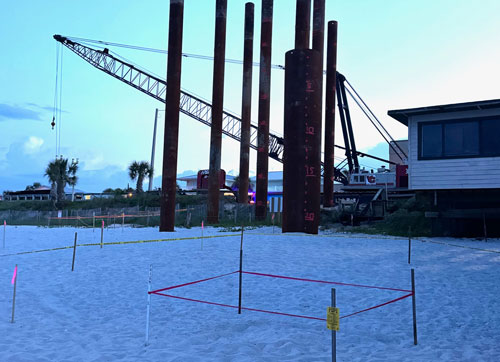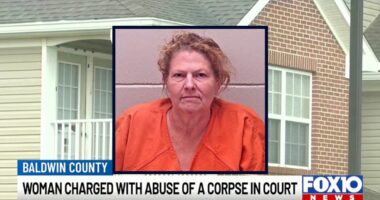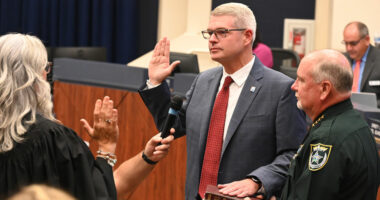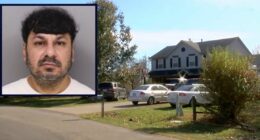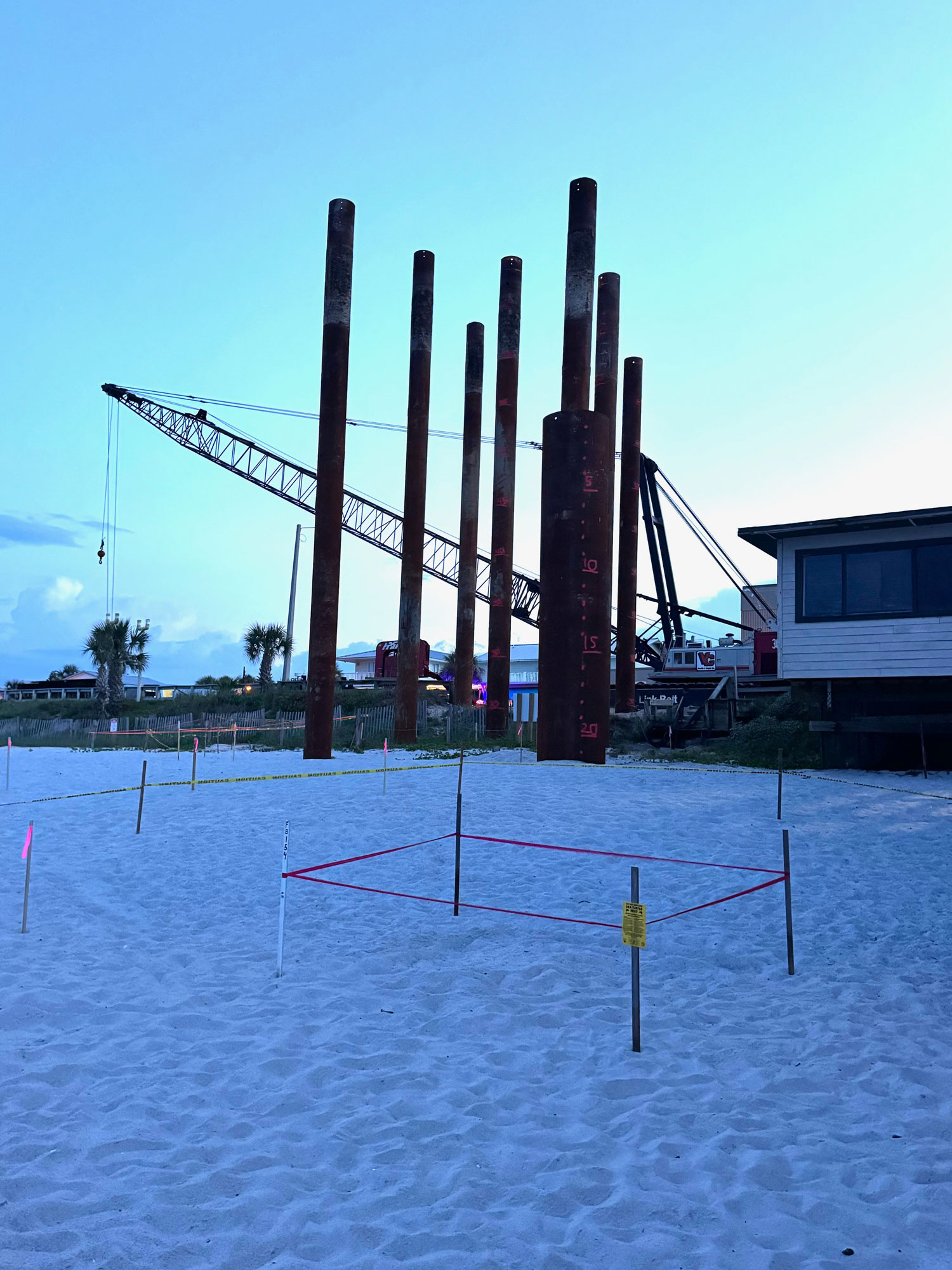
The Flagler Beach pier demolition and reconstruction project is coming to a halt next Wednesday. Two new turtle nests burrowed in the path of the large trestle under construction are stopping work on the $16 million project. It will resume in about two months, after the turtles have hatched.
The due date for the newest turtle nest is not before Sept. 10.
Redesigning the trestle path to avoid the nests would be too expensive and may take long enough that by the time the redesign is complete, the turtles may have hatched anyway, construction engineers and city officials determined.
So City Manager Dale Martin said this morning he is following the city engineer’s recommendation to suspend construction “and be patient for a month and a half, two months.” Preliminary work will continue through Tuesday, then will begin what he calls the “turtle nest delay.”
A green turtle–the largest among the nesting turtles–dug the first nest over three weeks ago, says Lori Ottlein of the Flagler Turtle Patrol. That necessitated a workaround just as the first piling was about to be drilled. It was moved just enough to give the nest a 20-foot buffer. Work continued.
“Then of course Sunday, little miss loggerhead decided to come up and nest right smack in the middle of the plan,” Ottlein said.
The nests had the planned trestle essentially surrounded.

Vecellio and Grogan, the contractor, had been driving huge metal piles into the ground as the foundation for a trestle that will parallel the pier. The platform will enable heavy equipment to conduct the demolition, then the reconstruction.
Justin McKay, the project manager for Vecelio and Grogan, late Wednesday morning informed the city administration of the nesting dilemma and outlined options. Other than waiting out the nests, none of the options were attractive or cost-effective.
“I have been in discussions with our Specialty Trestle Design Engineer, and he is having difficulty designing around Sea Turtle Nest # 2,” McKay wrote. “He proposed a concept, but the only way he is able to make it happen would be to shift the entire Unit 1 of the trestle (which we are in the process of installing the piling for now), and adjust the radius of the trestle entry. This would require us pulling all of the piling we installed, relocating and then re-driving them. This also does not guarantee that the material haulers will be able to safely make the turn with the new proposed radius (our previous one was confirmed to work by the haulers themselves), so it may require future modifications, re-work, etc. at a later date. Impacts of this are impossible to determine at this time.”
Another option, McKay said, “would be to completely redesign and relocate the trestle South of Turtle nest 1, which would involve an entire redesign, and cause other issues.” Dunes would be further impacted and beach space available for the public would be further diminished. “We also run the risk of additional nests being created that may conflict with a new trestle design,” he wrote.
To do that, the company would have to redesign the trestle (the original trestle took a month to design) and get it reviewed by regulatory agencies, and its prefabrication altered.
“The final option that I can think of is to wait out the incubation period, and resume work once the eggs have hatched,” McKay said. “In this case, V&G will make best effort to mitigate costs incurred by things within our control.” He left it to the city manager to advise on how to proceed.
City Engineer Bill Freeman told Marin that he was “not optimistic about coming up with the alternative that is much different than waiting the 55 – 70 day incubation period.”
The Florida Fish and Wildlife Conservation Commission issues permits for relocating nests. But it’s not as simple as it sounds. The contractor would have had to secure those permits before construction began. That’s what happened as the U.S. Army Corps of Engineers renourished the beach in the city last year. That did not happen in this case.
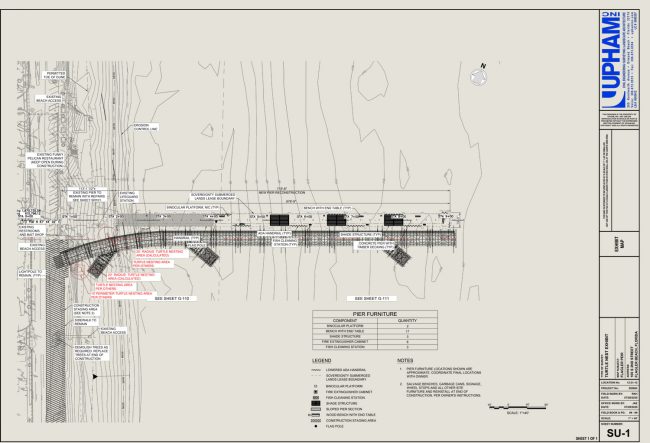
Had the permits been in hand, the nests could have been moved only within the very brief window–a matter of hours–between the time the eggs are laid and 9 a.m. of the first morning after the nesting. Beyond that, the nests may not be moved, Ottlein said. The hatching success of relocated nests is also lower than untouched nests.
“I guess we just have to follow the rules and regs put in place by the Florida Department of Environmental Protection and FWC and follow the proper protocols and procedures,” Flagler Beach Commission Chair James Sherman said.
The Flagler Turtle Patrol “flags” each nest: the “flagging” date is the same as the due date. The first nest is flagged for August 16. That doesn’t mean the hatchlings will emerge that day, necessarily. They could take up to 15 days from that date.
The second nest is flagged for September 10. Ottlein said the turtles this season have been hatching at the 60-day mark. “The hotter it gets, the faster they’re going to hatch,” she said. Each nest, protected by a 10-by-10 enclosure, may produce between 80 and 140 hatchlings. But theirs are lives of fragility and predatory fates. Only one in 1,000 will survive to age 25, the age at which turtles may begin laying eggs. Survivors live beyond 80 years.
Their nests are also fragile. “Nobody really knows how that pounding of the pilings might affect the eggs,” Ottlein said. “20 feet away might be good, maybe it’s not. This isn’t something we’ve encountered. They might be OK. We don’t know.”
The Turtle Patrol has documented 163 nests in Flagler Beach alone so far this season (from Snack Jack’s to the Beverly Beach town limit), and over 500 nests from the Beverly Beach town limit to Washington Oaks Gardens State Park.
“It sounds like with the different options to redesign, possibly refabricate, pull out the already installed pilings, the alternative to wait until the incubation period may be the most feasible,” City Commissioner Scott Spradley said. “It’s just a fact of living in a coastal environment. We all have had the expectation of possible delays anyway, for hurricanes. This is one many of us did not foresee. But it’s just as much a reality.”
